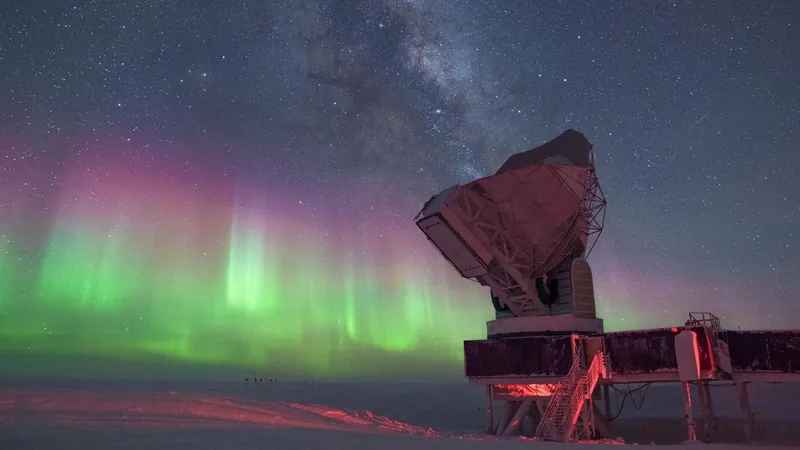
Groundbreaking Discoveries at the South Pole Telescope Reinforce the Standard Cosmological Model
2024-11-14
Author: Wei
Groundbreaking Discoveries at the South Pole Telescope Reinforce the Standard Cosmological Model
In the vast expanse of our universe, a pivotal moment occurred roughly 400,000 years after the Big Bang: the cosmos cooled sufficiently to allow photons to break free from the dense, primordial "soup" of particles, marking the birth of light. This ancient light, now referred to as the Cosmic Microwave Background (CMB), has been the focal point of astrophysical inquiry for decades.
Recent findings from the South Pole Telescope, based at the National Science Foundation's Amundsen-Scott South Pole Station in Antarctica, have furnished scientists with critical observational data from this remnant light. This major contribution to our understanding of cosmic history has emerged from a collaborative effort led by the University of Chicago and includes researchers from UC Davis.
The study, which has been submitted to the journal *Physical Review D* and is available on the arXiv preprint server, meticulously analyzed high-precision measurements of the CMB and its polarized light. The outcomes bolster the credibility of the standard cosmological model—a framework that explains the evolution of the universe over the past 14 billion years. Importantly, the research provides a fresh calculation of the Hubble constant, revealing new insights into a prominent scientific quandary dubbed "the Hubble tension."
As described by Lloyd Knox, the Michael and Ester Vaida Endowed Chair in Cosmology and Astrophysics at UC Davis and a co-author of the study, the current understanding of cosmic evolution is "largely coherent, detailed, and successful." However, he noted that the underlying causes of the initial inhomogeneities that eventually shaped the structures of the universe remain a mystery.
This study stands out as it represents the first competitive constraints on cosmological models relying solely on CMB polarization data, establishing a nearly independent stance from previous findings that predominantly utilized total intensity. This method marks a significant advancement in the field.
To achieve these findings, researchers evaluated two years of polarized light data collected by the South Pole Telescope from 2019 to 2020, covering a staggering 1,500 square degrees of the sky. This data has enabled scientists to construct an extensive map of the universe's mass distribution.
Light, in its natural state, is typically unpolarized, a random assortment of waves oscillating in various directions. However, when light reflects off surfaces, it can become polarized, which is how polarized sunglasses function to reduce glare. This phenomenon also applied to the CMB photons as they underwent their final scattering in the early universe.
The partially polarized light from the CMB traversed vast distances before reaching us, yet its journey was not without distortion. Gravitational forces warped the paths of these photons—a phenomenon referred to as gravitational lensing. Fittingly, to visualize how the image would appear absent of lensing effects, the research team utilized high-performance computing resources at the National Energy Research Scientific Computing Center (NERSC) in Berkeley.
Marius Millea, a project scientist involved in the study, explained the team's approach, highlighting the intricacies of their data analysis. The challenge was not just to process this complex information but to create a model that aligns with the observable phenomena.
The current research carries significant implications, especially regarding the ongoing debate over the Hubble tension. This issue revolves around the discrepancies in the measured rates of the universe's expansion using different methodologies.
On one hand, cosmologists predict the expansion using the standard cosmological model together with CMB observations. On the other, supernovae provide a direct measurement of the universe's expansion rate, with recent findings suggesting a faster expansion than the standard model forecasts. The current study's utilization of polarization data provides a new prediction that aligns with CMB intensity maps from the European Space Agency's Planck satellite and deviates significantly from supernova measurements, intensifying the conversation around the Hubble tension.
As scientists continue to delve into these cosmic mysteries, the insights gleaned from the South Pole Telescope not only reinforce our understanding of the universe's history but also provoke questions about the very nature of its expansion. What other revelations lie hidden in the depths of the cosmos, and how will they challenge our perception of reality? Stay tuned to find out!


 Brasil (PT)
Brasil (PT)
 Canada (EN)
Canada (EN)
 Chile (ES)
Chile (ES)
 Česko (CS)
Česko (CS)
 대한민국 (KO)
대한민국 (KO)
 España (ES)
España (ES)
 France (FR)
France (FR)
 Hong Kong (EN)
Hong Kong (EN)
 Italia (IT)
Italia (IT)
 日本 (JA)
日本 (JA)
 Magyarország (HU)
Magyarország (HU)
 Norge (NO)
Norge (NO)
 Polska (PL)
Polska (PL)
 Schweiz (DE)
Schweiz (DE)
 Singapore (EN)
Singapore (EN)
 Sverige (SV)
Sverige (SV)
 Suomi (FI)
Suomi (FI)
 Türkiye (TR)
Türkiye (TR)
 الإمارات العربية المتحدة (AR)
الإمارات العربية المتحدة (AR)